Nathalie Daoust “Korean Dreams” 18.11 – 21.12.2017
October 8, 2017 10:00 pmFrom November 18th through December 21st, 2017. Opening Saturday November 18th 5pm-7pm. The Canadian photographer Nathalie Daoust, born in 1977, explores secrets and taboos, balancing on the thin line between reality and fantasy. For her newest project “Korean Dreams”, she travelled to North Korea, capturing scenes of one of the world’s most secretive societies. Many of her photographs are candid and were taken using a remote trigger to avoid detection. “Korean Dreams”, is a complex series that probes the unsettling vacuity of North Korea. Piercing its veil with her lens, these images reveal a country that seems to exist outside of time, as a carefully choreographed mirage. Daoust has spent much of her career exploring the chimeric world of fantasy: the hidden desires and urges that compel people to dream, to dress up, to move beyond the bounds of convention and to escape from reality. With Korean Dreams she is exploring this escapist impulse not as an individual choice, but as a way of life forced upon an entire nation. Daoust deliberately obscures her photographs during the development stage, as the layers of film are peeled off, the images are stifled until the facts becomes ‘lost’ in the process and a sense of detachment from reality is revealed. This darkroom method mimics the way information is transferred in North Korea – the photographs, as the North Korea people, are both manipulated until the underlying truth is all but a blur. The resultant pictures speak to North Korean society, of missing information and truth concealed.
De Canadese fotograaf Nathalie Daoust, geboren in 1977, verkent geheimen en taboes op de dunne lijn tussen realiteit en fantasie. Voor haar nieuwste project “Korean Dreams” reisde ze naar Noord-Korea, waarbij ze scènes van een van de meest geheimzinnige samenlevingen van de wereld vast heeft kunnen leggen. Veel van haar foto’s zijn openhartig en werden genomen met behulp van een externe cameraknop om detectie te voorkomen. Fotograaf Nathalie Daoust’s nieuwste project, Korean Dreams, is een complexe serie die de verontrustende vacuümachtige leegte van Noord-Korea probeert te doorgronden. Trachtend deze sluier middels haar lens te doorbreken, onthullen haar beelden een land dat buiten de tijd lijkt te bestaan, als een zorgvuldig gechoreografeerde mirage. Daoust heeft een groot deel van haar carrière besteed aan het verkennen van schimmige fantasiewerelden: de verborgen verlangens en dringende krachten die mensen dwingen om te dromen, zich te verkleden, de grenzen van conventie en realiteit te ontsnappen. Met Koreaanse Dromen verkent ze deze escapistische impulsen. Niet als een individuele keuze, maar als een opgelegde en gedwongen manier van leven van een heel volk. Daoust verdoezelt en verbergt haar foto’s opzettelijk tijdens het ontwikkelen, door de lagen film één voor één te strippen, worden de beelden vervaagd totdat ‘feiten’ verloren gaan en een gevoel van losraken van de realiteit wordt opgeroepen. Deze doka-methode toont gelijkenissen met de manier waarop informatie wordt verspreid en overgedragen in Noord-Korea. De foto’s, zoals ook de Noord-Koreanen, worden gemanipuleerd totdat de onderliggende waarheid aan totale vervaging en versluiering onderhevig is. De resulterende foto’s weerspiegelen de Noord-Koreaanse samenleving, een maatschappij van ontbrekende informatie en verborgen waarheid. – Samantha Small – De opening van Korean Dreams vindt plaats op zaterdag 18 november in Gallery WM van 17-19 uur. De kunstenaar, Nathalie Daoust, zal aanwezig zijn op de opening.

Traffic Lights © Nathalie Daoust
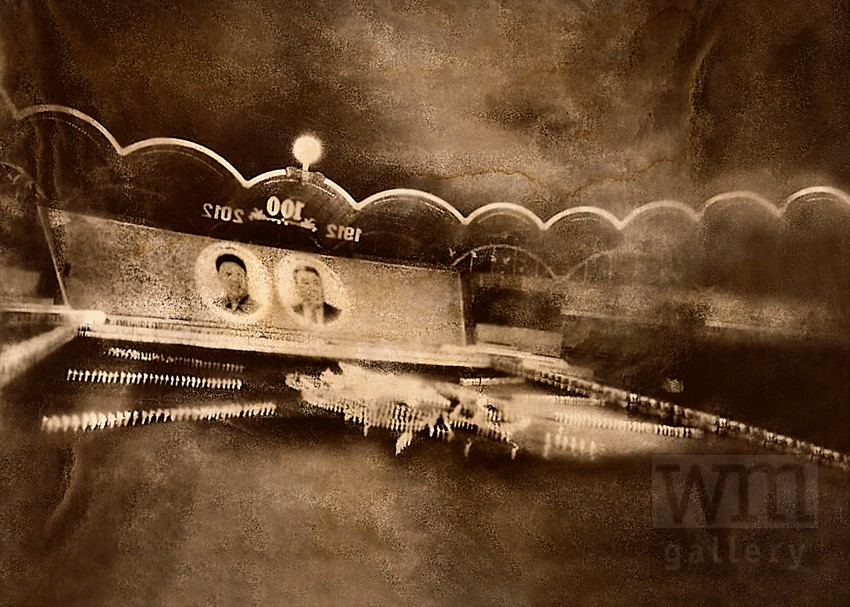
Arirang © Nathalie Daoust
Interview with Nathalie Daoust (in Planet 9) In her series Korean Dreams (2016) photographer Nathalie Daoust (*1977, Montreal, Canada) inquires the enigmatic world of North Korea. Her images reveal a country that exists isolated from the rest of the world. Within her photographic process she reflects the fabrication of truth in this seemingly perfect social system. Why did you travel to North Korea with your camera? I was working on a project on North Korean women living in hiding in China. To understand it better I traveled to North Korea to see what they were running away from. After many months of research on North Korea, I decided to create works spreading more awareness about what is happening there. Under what circumstances were you able to photograph there? It is very difficult to enter North Korea as a journalist or a photographer, so I decided to enter it as a tourist. The people who helped me get there said it would be risky for me, since there had been some articles published online about my project in China with the North Korean women. It took around six months to have all the information removed from the Internet, and then I was able to travel without any problems. Once I was in North Korea I was allowed to take photographs in the tourist area. When I was in places where photography was forbidden, I was able to take photos with a hidden cable release. That is why many of my photos are taken from waist height. What do your photographs show? Emptiness. That was the first impression I had of North Korea. The streets, highways, and even most tourist places we visited were empty. There was a feeling of isolation and a gap between truth and fiction. If you look closely, sometimes parts of the images are sharp (little moments of truth), but most of them are fuzzy. Why did you choose a technique that obscures the photograph, which is usually seen as objective and true? I was inspired to use this technique because“truth” in North Korea is largely fictional. Hence, I wanted to convey what is really happening in a country that suppresses information and conceals reality. The method, called image peeling, deletes elements of the picture through repeated cycles of peeling and reprinting it. Thus it mimics the regime’s carefully regulated transfer of information, which stifles the truth until the underlying facts are all but a blur. Consequently the photographs are as manipulated as the North Korean people whom they portray. credit: Kunsthalle Darmstadt for Planet 9 (May 3 – August 27, 2017)
Opening @ WM, November 18th, 2017 with Nathalie Daoust
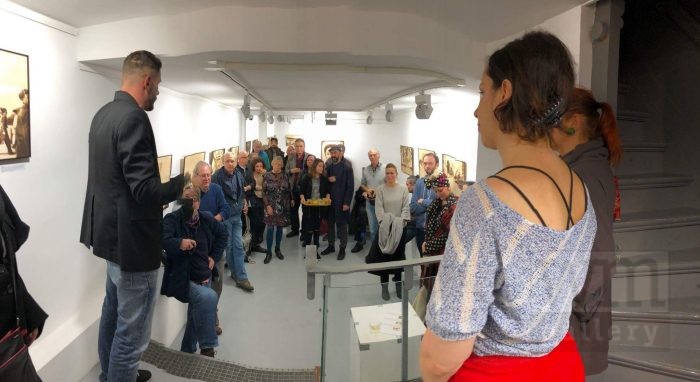
opening speech by curator Sebastian Rypson, © Willem Overtoom

photo © Wanda Michalak
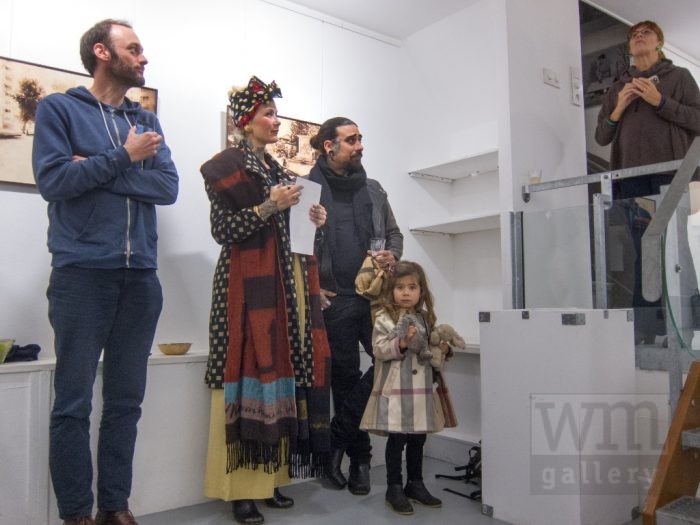
photo © Pete Purnell
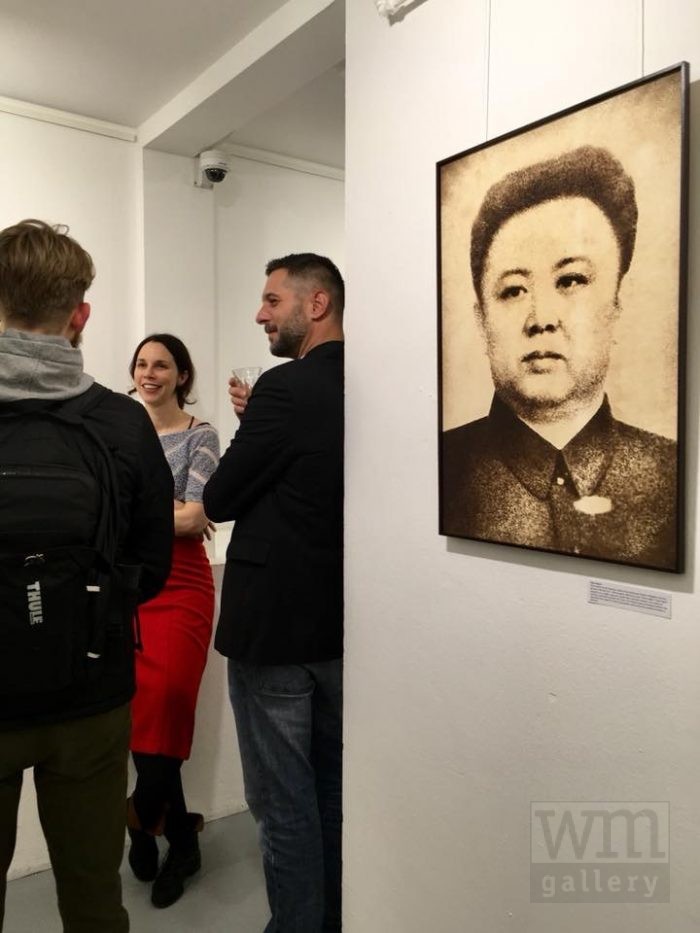
photo © Wanda Michalak
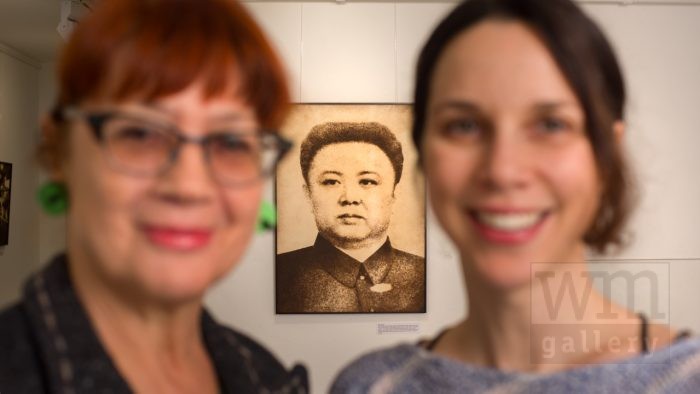
Wanda and Nathalie, photo © Pete Purnell
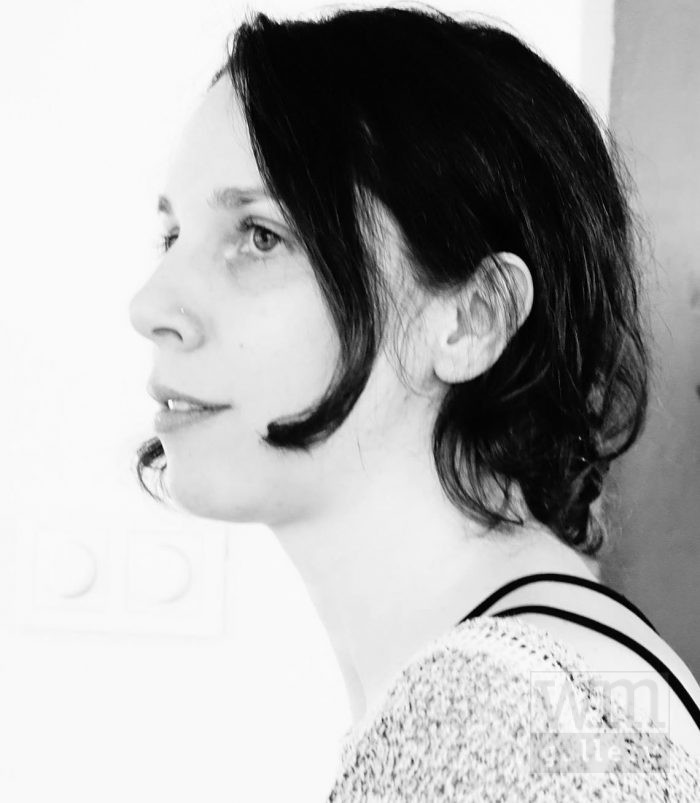
Nathalie Daoust, photo © Dixie Solleveld
Media
- Het Parool, Peter van Brummelen, 16 November 2017 : crop_2017-11-16_Het_Parool_-_16-11-2017_28
- If there is now, Walter van Teeffelen, 20 December 2017 : http://bit.ly/2B5Tmja
World Fine Art Professionals and their Key-Pieces, 152 – Nathalie Daoust
Walter van Teeffelen–
From waist height
As it was difficult to enter North Korea as a journalist or a photographer, she decided to enter the country as a tourist. “The people who helped me get there said it would be risky for me, since there had been some articles published online about my project in China with the North Korean women. It took around six months to have all the information removed from the Internet, and then I was able to travel without any problems. Once I was in North Korea I was allowed to take photographs in the tourist area. When I was in places where photography was forbidden, I was able to take photos with a hidden cable release. That is why many of my photos are taken from waist height.” Having experienced North Korea in the flesh, she felt compelled to create a separate series of images on the real conditions that exist inside the country in order to raise awareness around the plight that millions of people live in. It is the primary concern of this exhibition, she says. The exhibition is travelling in several countries.
Three-generation policy
“Until I went there, I didn’t understand why, after so many years of repression, the people of North Korea do not just stand up and fight for their freedom. However, after being there and doing extensive research on the country, I now understand and have great sympathy for the situation in which the North Korean people find themselves.” Executions and false imprisonment are commonplace. “You can spend up to ten years in prison for just wearing jeans, which are forbidden by the state. As an extra deterrent, there is also a three-generation policy. Even if you are willing to risk your life for the greater good of freeing your country, if you get caught, your children, parents and grandparents also receive the same punishment. This makes change almost impossible.”
Escaping from reality
Escaping from everyday reality and everyday life is a recurring theme in Nathalie’s work. “I feel that everyone has their own way to escape from their everyday reality and their everyday life. I am very interested in understanding the what, where and why of this.” In the past she focused on individuals escaping from their own reality.
One example is a project she did on a man who dressed like Mao Zedong. “He was otherwise a very normal man that no one would notice in the crowded streets of China. However, when he dressed up as Mao Zedong, he suddenly became important and people talked to him. This made him feel more powerful enabling him to escape from his impoverished life even if just for a few hours. He told me that he did this simply because he enjoyed the way that it felt (it was not a job). This momentary feeling of escapement was enough for him.“
In another project, she photographed an S&M love hotel in Japan where clients escape from their everyday lives. “Here, I was fascinated both by where people go for such escape (the Alpha-In) and by the women they pay to help them achieve this escapement.”
The darkroom
Nathalie Daoust graduated from photography school in 1997, 20 years ago. Right after she moved to New York to start her first photo series New York Hotel Story. “It involved photographing every room of an art hotel and the artist who decorated it.”
What she loves about photography is that it shows ‘reality’. “However, a raw negative does not always express the feeling, interaction, atmosphere, and connection felt between the subject and location. I often experience an energy and feeling while taking photos that the camera simply cannot capture. This is where in the darkroom comes. I can manipulate the photos to represent how I felt in that exact moment.”
For example in North Korea she felt like everyone she met was ‘not there’, disconnected and beyond reach. “I never felt that I was able to form a clear picture of North Korea and that most of the information that I was told was obscured and lost at every turn. That is why I developed a technique in the darkroom to instill the images with this same feeling. This involved exposing and peeling the prints over and over again to mimic the way that information is lost through the myriad layers of oppression and censorship that exist in North Korea. In effect, you need to peel many layers before reaching the truth. This technique also captures the strong sense of detachment from reality that I felt when I was there and represent more the feeling I had of missing information and truth concealed.”
Mimicking
Nathalie concludes: “Truth in North Korea is largely fictional. Hence, I wanted to convey what is really happening in a country that suppresses information and conceals reality. Thus it mimics the regime’s carefully regulated transfer of information, which stifles the truth until the underlying facts are all but a blur. Consequently the photographs are as manipulated as the North Korean people whom they portray.” Walter van Teeffelen 20.12.2017 for full article see http://bit.ly/2B5Tmja

